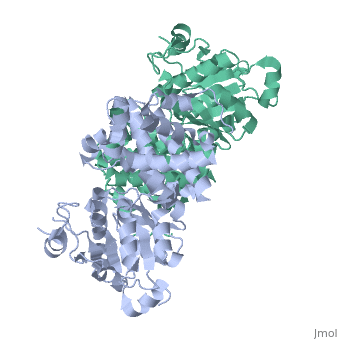Glycerol-3-Phosphate Dehydrogenase
From Proteopedia
Glycerol-3-phosphate dehydrogenase (GlpD) is a membrane bound enzyme in prokaryotes and in eukaryotes. Glycerol 3-Phosphate Dehydrogenase (GlpD) is an oxidoreductase enzyme which catalyzes the reduction in reaction of Dihydroxyacetone Phosphate to Glycerol 3-Phosphate, with NADH as the reductant. GlpD is involved in many cellular functions such as phospholipids biosynthesis, respiration and metabolism. [1]The GlpD is a dimer consisting of two subunits which contain the catabolite activator protein (CAP)-Domain,the flavin adenine dinucleotide(FAD)-Domain and a ubiquinone analogue, MD.
StructureGlpD is a dimer that consists of two subunits; α and β. The GlpD structure also contains seven ligands; 1,3-Dihydroxyacetonephosphate (13P), β-Octylglucoside (βOG), 1,2-Ethanediol (EDO), Flavin-Adenine Dinucleotide (FAD), Imidazole (IMD), PO4 (Phosphate Ion) and N-(Tris(Hydroxymethyl)methyl)-3-Aminopropanesulfonic Acid (T3A). The active sites on GlpD are the Cap-Domain, FAD- Domain and a ubiquinone substrate analogue, menadione (MD). The C-terminal CAP-Domain consists of negatively charged residues that are opposite in orientation to the positively charged residues of the FAD-Domain in the phospholipid membrane. The CAP-domain is responsible in gene transcription and helical turns. The N-terminal FAD-Domain exists in each monomer subunit of GlpD and is embedded into the phospholipid membrane bilayer.Substrate binding occurs at this domain which causes a conformational change to the structure of the GlpD enzyme. The FAD-domain plays a major role in metabolism and energy synthesis. The active site is found in a cleft between the two domains[2]. FunctionGlpD functions in the intracellular membrane of E. coli and in the inner-mitochondrial membrane of eukaryotes. In E. Coli, GlpD catalyzes and reduces the reaction of dihydroxyacetone phosphate (DHAP) to glycerol 3-phosphate in the glycerol metabolism pathway. The binding of the substrate analogues (glyceraldehydes 3-phosphate, glyceric acid 2-phosphate and phosphoenolpyruvate, dihydroxyacetone phosphate) or UQ substrate analogues (2-n-heptyl-4-hydroxyquinoline N-oxide and menadione). The conformational change of the structure and resiudes of GlpD catalyzes many different metabolic reactions. Metabolic PathwaysPhosphoplipid BiosynthesisGlpD reduces DHAP to glycerol 3-phosphate. Then the glycerol 3-phosphate is catalyzed by acyl transferase to 1-acylglyverol-3-phosphate, and then another acyl transferase catalyzes that to a phosphatidic acid. head groups are added to the phosphatidic acid to synthesize phospholipids. GlyceroneogenesisGlpD is also involved in the glyceroneogenesis pathway. By gluconeogenesis, phosphoenolpyruvate converts to dihydroxyacetone phosphate which is reduced by GlpD to glycerol 3-phosphate which then forms a backbone for the synthesis of triacylglycerol. RespirationThe FAD-domain in GlpD plays a major role in the transport of electrons into the repiratory pathway. Glycerol 3-phosphate is oxidized to dihydroxyacetone phosphate with simultaneous reduction of of FAD to FADH2 occuring, and the electrons are transported to Ubiquinone, which are further transported to oxygen or nitrogen and into the respiratory pathway. DiseasesGlpD is involved in diseases such as Alzeheimer`s, muscle dystrophy, hyaline membrane diseases and many more. 3D structures of glycerol-3-phosphate dehydrogenaseGlycerol-3-phosphate dehydrogenase 3D structures
|
| |||||||||||
References
- ↑ Yeh JI, Chinte U, Du S. Structure of glycerol-3-phosphate dehydrogenase, an essential monotopic membrane enzyme involved in respiration and metabolism. Proc Natl Acad Sci U S A. 2008 Mar 4;105(9):3280-5. Epub 2008 Feb 22. PMID:18296637
- ↑ Yeh JI, Charrier V, Paulo J, Hou L, Darbon E, Claiborne A, Hol WG, Deutscher J. Structures of enterococcal glycerol kinase in the absence and presence of glycerol: correlation of conformation to substrate binding and a mechanism of activation by phosphorylation. Biochemistry. 2004 Jan 20;43(2):362-73. PMID:14717590 doi:10.1021/bi034258o
Proteopedia Page Contributors and Editors (what is this?)
Indu Toora, Michal Harel, Alexander Berchansky, David Canner, Andrea Gorrell, Andrew Rebeyka, Jaime Prilusky


